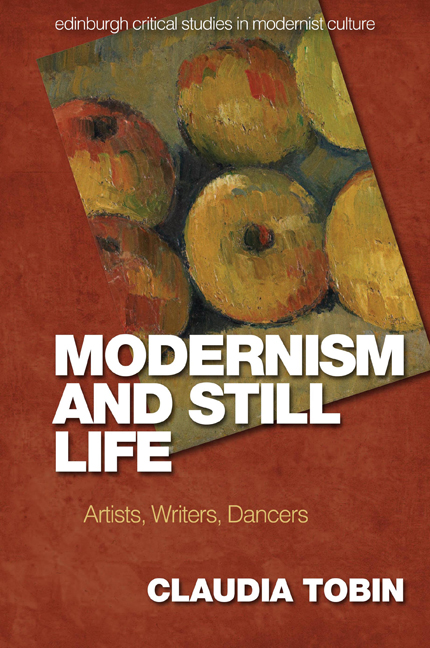Book contents
- Frontmatter
- Contents
- List of Figures and Plates
- List of Abbreviations
- Acknowledgements
- Series Editors’ Preface
- Introduction: ‘Nothing is really statically at rest’: Cézanne and Modern Still Life
- 1 ‘Quivering yet still’: Virginia Woolf, Roger Fry and the Aesthetics of Attention
- 2 Still Life in Motion
- 3 ‘Past the gap where we cannot see’: Still Life and the ‘Numinous’ in British Painting of the 1920s–1930s
- 4 ‘Inactive contemplation’: Wallace Stevens and Charles Mauron
- Conclusion: ‘On the very brink of utterance’: Aldous Huxley, Mark Gertler and Transfigured Things
- Bibliography
- Index
- Plate Section
Conclusion: ‘On the very brink of utterance’: Aldous Huxley, Mark Gertler and Transfigured Things
Published online by Cambridge University Press: 08 October 2020
- Frontmatter
- Contents
- List of Figures and Plates
- List of Abbreviations
- Acknowledgements
- Series Editors’ Preface
- Introduction: ‘Nothing is really statically at rest’: Cézanne and Modern Still Life
- 1 ‘Quivering yet still’: Virginia Woolf, Roger Fry and the Aesthetics of Attention
- 2 Still Life in Motion
- 3 ‘Past the gap where we cannot see’: Still Life and the ‘Numinous’ in British Painting of the 1920s–1930s
- 4 ‘Inactive contemplation’: Wallace Stevens and Charles Mauron
- Conclusion: ‘On the very brink of utterance’: Aldous Huxley, Mark Gertler and Transfigured Things
- Bibliography
- Index
- Plate Section
Summary
In his review of Mark Gertler's 1922 exhibition, Huxley appends the subtitle, ‘A Painter Who Knows How to Record the Qualities of Things’. Huxley‘s analysis of Gertler returns this inquiry, by way of a conclusion, to those questions about the eloquent yet disquieting life of objects with which we began. What happens when still life permeates other genres, for instance when portraits or landscapes become still lifes? What happens when the living animates the still? What is the difference between ‘material’ and ‘spiritual’ comprehension of everyday objects? In Huxley's early poetry, still life is a symbol of modern instability and an object of parody, but it also functions as a metaphor for ways of seeing and interpreting the world in his art criticism, which gain validation decades later in his meditation on visionary experience under the influence of mescaline, The Doors of Perception (1954).
What particularly attracts Huxley to Gertler's work is the ‘wonderfully satisfying sense of mass and solidity’ in his still lives’ (p. 69). Identifying qualities that his friend D. H. Lawrence and many others had admired in Cézanne, Huxley observes the way Gertler paints the solidity and texture of objects with ‘a strange intensity of vision’ that gives them ‘extraordinary significance’ and seems to penetrate their ‘material essence’ (p. 68). It is this capacity to communicate on the level of physical response that Huxley emphasises in Gertler's rendering of bottles, china figures and draperies which ‘produce an almost tactile impression’ on the viewer and enable them to ‘share his feeling for the material essence of things’ (p. 69). A painting by Gertler titled Meditation illustrates Huxley's article, depicting a languid nude in an armchair, her limbs hanging heavily, one hand loosely holding a book. For Huxley, this is not a portrait but rather the painter's ‘application of the still life method to a study of the nude’ (p. 69).
Gertler's paintings of the early 1920s can be situated in the tradition of the sensuous, luxuriant still life. Fruit, drapery and voluptuous human flesh are brought into close relationship in The Queen of Sheba (1922) (plate 26), a painting which was exhibited with the London Group the same year.
- Type
- Chapter
- Information
- Modernism and Still LifeArtists, Writers, Dancers, pp. 203 - 213Publisher: Edinburgh University PressPrint publication year: 2020



